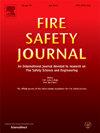Modeling study on the pyrolysis kinetics of wood composite in the thermally thin regime: The role of heating rates and thermal gradients
IF 3.4
3区 工程技术
Q2 ENGINEERING, CIVIL
引用次数: 0
Abstract
Pyrolysis of wood composites is a complex process involving reactions with its primary condensed components: cellulose, hemicellulose, and lignin. Thermogravimetric Analysis, within the thermally thin regime, is extensively employed to deduce the kinetics of wood pyrolysis. However, the correlation between heating rates and the pyrolysis kinetics of each component remains unclear, raising concerns about the applicability of these rates in estimating kinetics under varying heating conditions. This paper focuses on examining the influence of heating rate and thermal gradients on the pyrolysis kinetics of wood composite components through a modeling study. The impact on kinetic parameters is analyzed using various chemical mechanisms. These parameters are determined using a model fitting method, which extracts a unique set of kinetics for each heating condition. The study reveals that the heating process interacts significantly with the overall pyrolysis process, and each thermal decomposition reaction of the condensed components is differently influenced by this process. The pyrolysis reaction rate and final mass fraction of the different components vary under distinct heating rates. Notably, higher heating rates tend to shift reactions to higher temperatures, and the interaction between thermal processes and pyrolysis reactions intensifies at increased global heating rates. This paper offers significant insights and considerations for simulating the thermal decomposition of wood on a larger scale.
热薄状态下木质复合材料热解动力学的模拟研究:升温速率和热梯度的作用
木质复合材料的热解是一个复杂的过程,涉及其主要凝聚成分:纤维素、半纤维素和木质素的反应。热重分析,在热薄状态下,被广泛用于推断木材热解动力学。然而,加热速率与每种组分的热解动力学之间的相关性仍然不清楚,这引起了人们对这些速率在不同加热条件下估计动力学的适用性的关注。通过模拟研究,研究了升温速率和热梯度对木质复合材料组分热解动力学的影响。分析了各种化学机理对动力学参数的影响。这些参数是使用模型拟合方法确定的,该方法为每个加热条件提取了一组独特的动力学。研究表明,加热过程与整个热解过程相互作用显著,且各缩合组分的热分解反应受加热过程的影响不同。不同加热速率下,不同组分的热解反应速率和最终质量分数不同。值得注意的是,较高的升温速率倾向于将反应转移到更高的温度,并且随着全球升温速率的增加,热过程和热解反应之间的相互作用加剧。本文为模拟更大规模的木材热分解提供了重要的见解和考虑。
本文章由计算机程序翻译,如有差异,请以英文原文为准。
求助全文
约1分钟内获得全文
求助全文
来源期刊

Fire Safety Journal
工程技术-材料科学:综合
CiteScore
5.70
自引率
9.70%
发文量
153
审稿时长
60 days
期刊介绍:
Fire Safety Journal is the leading publication dealing with all aspects of fire safety engineering. Its scope is purposefully wide, as it is deemed important to encourage papers from all sources within this multidisciplinary subject, thus providing a forum for its further development as a distinct engineering discipline. This is an essential step towards gaining a status equal to that enjoyed by the other engineering disciplines.
 求助内容:
求助内容: 应助结果提醒方式:
应助结果提醒方式:


